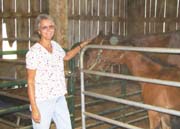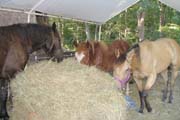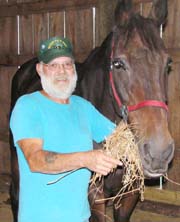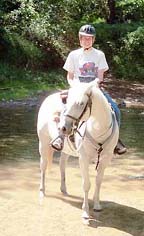The Horse Rescuers

A new breed of farmers is breaking a link in a surprising food chain
By Nancy Hoffmann
Flint, a young Percheron gelding, tried to leap over the stall door. He got hung up by a hind leg, struggled for a moment, then untangled himself. Loose, he pranced around the small pasture.
“The PMU weanlings come wild like deer,” Melody Parrish says about Flint and other horses born to mares who are reared and raised solely for the medical value of their urine.
“They’ll climb a wall,” Parrish adds. That’s why all new arrivals at Freedom Hill Horse Rescue go straight into a stall and don’t come out until they’re willing to let Parrish touch them.
Flint’s first day, he had preferred running through the electric fencing to trusting a human. Two other horses that had arrived with him followed into the woods.
It was late, and Parrish wondered how she was going to find three scared horses in the dark. What had she gotten herself into?

Cows to Cowed Horses
For 18 years, Chrystal and Harry Hill, Parrish’s mother and step-father, raised polled Hereford cattle, which are born without horns, on their Mount Harmony Farm in Owings. Two years ago, they sold the last of the cattle and started thinking about selling the 32-acre farm and moving to Pennsylvania.
“We didn’t move fast enough,” Harry Hill says with a laugh, “because in November 2004, Melody announced that somebody needed to put a horse rescue operation on this farm.”
“I never bought a solid, healthy, sound horse,” says Parrish, who has been riding and training horses for 30 years. “I always wanted to fix it up and pass it along.”
Thus began Freedom Hill Horse Rescue, which now comprises two farms, the Hill’s Mount Harmony Farm and Parrish’s five-acre Whispering Woods Farm.
All new arrivals start out at Whispering Woods, where they are quarantined for about 30 days. Vaccinations and worming are brought up to date, and the horses learn to accept Parrish’s touch.

PMU Farming
PMU stands for Premarin®, which is pregnant mares’ urine. Conjugated estrogens are extracted from the urine to be used in hormone replacement therapy. That demand has produced a new kind of horse farm; nowadays some 500 PMU farms, mostly in Canada, raise mares for urine much as cows are raised for milk. Many PMU farmers prefer draft horses, such as Percherons, because the larger horses produce more urine.
On PMU farms, mares spend about seven of their 11 months of pregnancy on the “pee line,” attached to tethers that collect their urine. They are unable to turn around or walk more than a few steps forward or back. To increase the concentration of estrogen in their urine, the mares’ access to water is restricted, humane organizations report.
When the mares are ready to foal, or give birth, they’re turned out in open pastures. The foals are allowed three to four months, instead of the usual six months, to nurse from their mothers. “They’re weaned in the fall, so from October to January,” says Parrish, there’ll be a glut of babies.” The mares, again impregnated, return to the pee line.
The foals filter down into the United States through North Dakota. Some will find good homes, but the vast majority is sent to slaughter. That trip may be interrupted by a stay at a feedlot to fatten them up before they are killed and sold to Asian and European markets.
“I decided those horses needed rescuing,” says Parrish. “They’re treated like cattle.”
Parrish fears she’ll soon have a new clientele.
In 2002, the Women’s Health Initiative found that hormone replacement therapy was associated with an increased risk of various forms of cancer. Parrish says that 70 PMU farmers lost their contracts with Wyeth-Ayert Laboratories, Inc., which produces Premarin® and related drugs. Now she worries what will happen to the mares now out of work.
For now, Freedom Hill joins with five other rescue organizations to buy PMU foals directly from a variety of Canadian farmers. Each rescued foal costs $500 to $800. This is more than the price paid by slaughter houses because, says Parrish: “We have to outbid the meatman.” Freedom Hill supports the cost by charging an adoption fee when the tamed horses are passed on. “We make no money,” says Parrish. “The money goes directly to the farmer.”

Culture Clash
Horses helped build our nation. They helped settle the American West. In Maryland and Virginia, wild horses roam the seashore. Horses race in the Preakness Stakes and jump fences in hunt cup races. They carry children at summer camp and trot along the trails of Patapsco Valley State Park. They even live in suburbia, grazing on farmettes. Horses are our livelihood, our companions, our pets, our history.
Horses are not our food, but the Humane Society of the United States estimates that each year more than 90,000 horses are slaughtered in this country. Horsemeat processed for human consumption is exported to Europe and Japan, where it is considered a delicacy and sold for as much as $20 per pound.
Slaughter is not euthanasia, which the Merck Veterinary Manual defines as “an easy, painless death.” Slaughter involves a very different sort of death.
Along with the PMU foals and mares, horses sold at livestock auctions often end up at the slaughterhouse. Unwitting owners looking for a good home for a horse they can no longer keep; stables looking to get rid of a horse that can no longer give lessons; breeding farms looking to off-load infertile broodmares — all feed this market.
“When people send their horses to auction,” says Parrish, “normally killer buyers buy up a lot of the horses.”
The buyers transport horses from around the country — often in trailers built to haul cattle, without stops for food or water, Parrish says — to three foreign-owned processing plants. Two are in Texas and one in Illinois.
“Our tax dollars are allowing what is against the law in this country to occur in other countries,” says Parrish. By that she means that the taxpayer supported United States Department of Agriculture inspects horsemeat and horses shipped across the U.S. border for slaughter. Horsemeat, however, cannot legally be sold for human consumption within the U.S.
“And the people don’t realize what’s in the horses,” she adds. “They’re stocked full of meds.” Horses are not raised for food, so they are given medicines never administered to animals raised for food. For instance, a daily wormer commonly used by horse stables states on its label that it should not be used on horses intended for food.
September 20 was a good day for horses and horse lovers in the United States. That’s the day the U.S. Senate approved the Ensign-Byrd Amendment to the Agriculture Appropriations bill. Once signed into law, the appropriations bill will end inspections, hence slaughter, for one year. It will, in effect, close the processing plants and prevent the export of horses for slaughter. During that year, animal welfare groups will work to pass the American Horse Slaughter Prevention Act, which would permanently ban horse slaughter.
Parrish calls the amendment “the beginning of the end to horse slaughter in the United States. There will be a glut of horses, but it’s an adjustment that needs to be made.”
Too Many Horses
In the old cow barn is Gabriel, who was separated from his mother the day he was born. The orphan foal’s story illuminates another aspect of the horse industry. The mare who bore him was a wet nurse, leased out to nurse another mare’s more valuable foal while that mare was either impregnated again or returned to sport competitions.
“They don’t look at it with any commitment to the animal’s life,” says Parrish of the industry
Gabriel is one of the lucky ones; rescued and hand raised, the four-month-old foal is ready for adoption.
Beside Gabriel are Sweetie and Happy Trails, mother and daughter. Sweetie was a trail horse; she was out for a ride when she suddenly dropped and delivered her foal. The stable owner hadn’t known she was pregnant. If Freedom Hill’s volunteers hadn’t raised the money to purchase them, mother and foal would have been sold to a killer buyer.
Just as there are too many cats and dogs, there are too many horses. But a dog or cat who lives 15 years has enjoyed a long life. Many horses live more than 30 years. It’s a long-term commitment horse owners and breeders are sometimes unable or unwilling to make.
So in steps Freedom Hill Horse Rescue, Parrish, the Hills and their many volunteers and supporters.
Forever Homes
As Parrish walks though the gate, Flint comes to her. The two mares who joined his earlier escape now crowd around, nuzzling Parrish for attention. Every day she brushes them down and picks up their feet, teaching them to stand still for the farrier who will trim their hooves every six weeks.
“I treat them as if they were my own horse,” says Parrish.
Soon they’ll be transferred to Mount Harmony Farm, where the Hills will care for them and volunteers will continue their training.
“They’re kept in training until the day they leave,” says Parrish, who’s still fixing up horses and passing them on to homes she hopes will last a horse’s lifetime.

